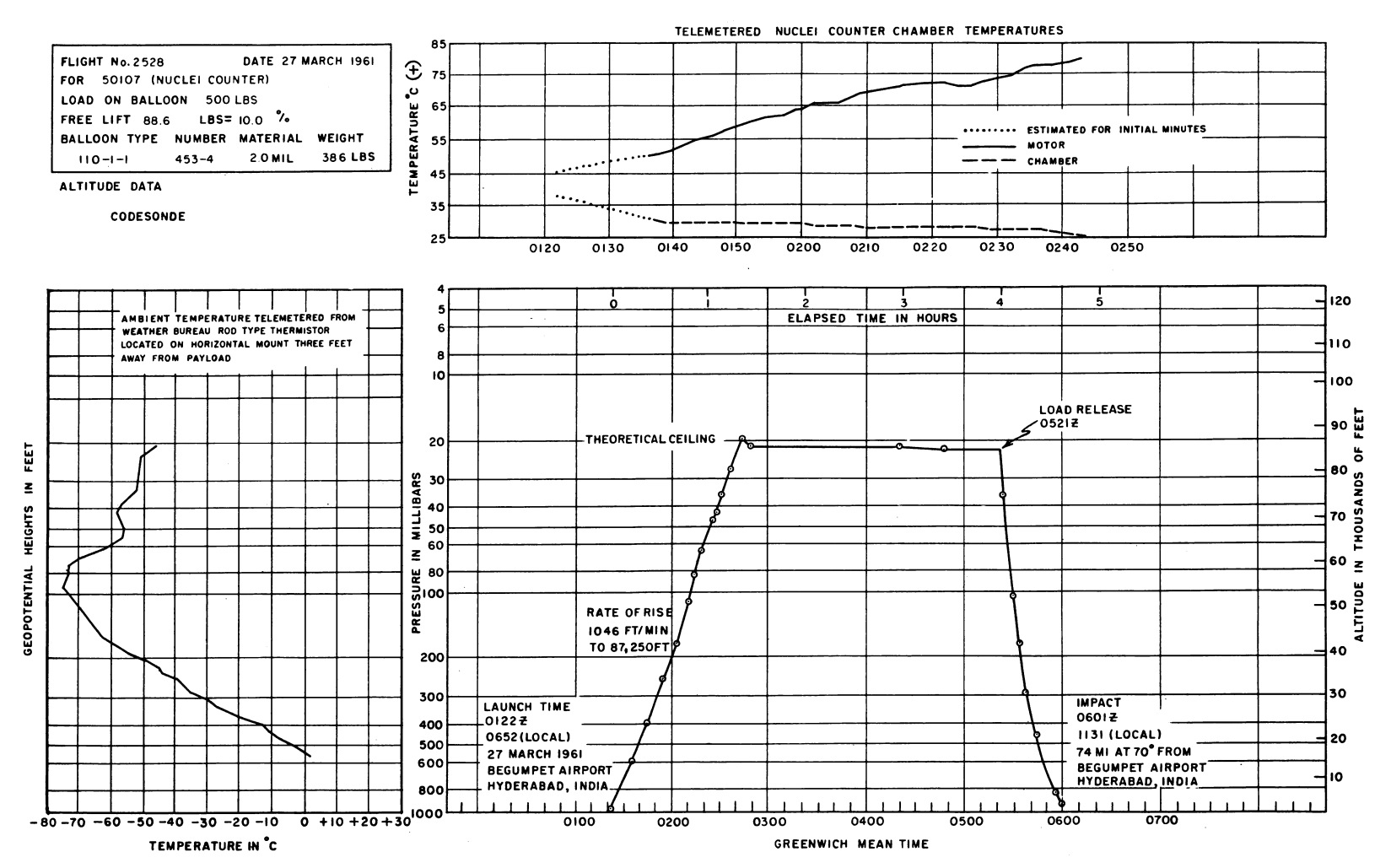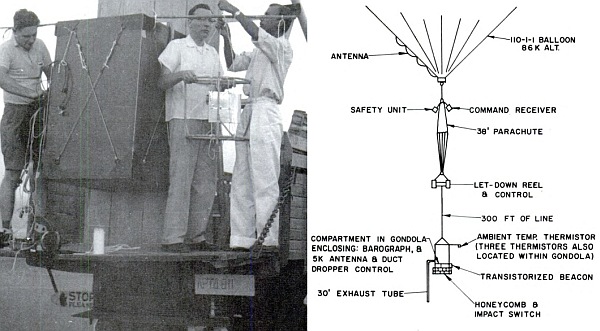Purpose of the flight and payload description
This flight was part of the Joint Indo-U.S. Balloon Flight Program - 1961 a cooperative scientific launch campaign carried out between February and April 1961 by scientists from India and the United States in Hyderabad, India. The objective of the extended series of high-altitude balloon flights was to probe the tropical stratosphere using a wide variety of scientific instruments.
The objective of the flight was to measure the vertical profile of the concentration of Aitken particles (particles with radii smaller than 0.14 microns) using an Aitken Nuclei Counter developed by the Air Force Research Division of the Air Research and Development Command. At left we can see the counter nuclei before flight along with the distribution of elements in the flight train. This instrument was based on the principle that if a highly illuminated cloud of water droplets is photographed, the picture consists of dots and circles depending upon the location of the droplets with respect to the focal plane. For a given photographic objective, the diameter of the circle determines the distance of the droplet from the focal plane. All droplets smaller than a certain size are located between two planes parallel to the focal plane. For a given optical system, an absolute determination of droplet concentration is thus possible, provided that the illumination is strong enough to depict all droplets within the two limiting planes.
The counter consisted of a cylindrical chamber, 12.6 cm long and 2.8 cm in diameter, expanded by the action of a piston at a ratio of 1,23. About 0.3 sec after expansion and consequent formation of the fog, a high-intensity strobe light illuminated a cylindrical section of the chamber about 1.5 cm long, which was photographed by a 35-mm Beattie-Coleman camera, together with the time and the frame number. Operation of the nuclei counter was continuous during the balloon flight, according to the following cycle: before and after expansion, the valves were opened, and the chamber was flushed with outside air at the rate of 50 cm3 per sec for 20 sec. Air entered the chamber through a half-inch intake tube, about 12 inches in length. Valves I and O were then closed and clean air from a tank was injected for 4 sec, raising the pressure of the chamber to one-half atmosphere above ambient. The air was allowed to rest in the chamber for 5 sec for mixing and moistening and then the piston was withdrawn, causing expansion, which was followed by the light flash and camera operation. Finally, water was injected into the chamber, and the cycle was repeated. The counter was designed to take measurements on the ascent only.
For the India campaign a series of four identical flights were planned with ascent to 86,000 ft of altitude at 1000 fpm rate of rise. Nuclei counter operated continuously from ground level at launch time until terminate at maximum altitude and descend by parachute. Additional equipment was required to telemeter pressure altitude, ambient temperature, and two temperature points within equipment gondola.
Details of the balloon flight

Balloon launched on: 3/27/1961 at 1:22 utc
Launch site: Begumpet Airport, Secunderabad, India
Balloon launched by: General Mills Inc.
Balloon manufacturer/size/composition: Zero Pressure Balloon General Mills 110-1-1 (2.0 mil)
Balloon serial number: 453-4
Flight identification number: GMI Nº 2528
End of flight (L for landing time, W for last contact, otherwise termination time): 3/27/1961 at 6:01 utc (L)
Balloon flight duration (F: time at float only, otherwise total flight time in d:days / h:hours or m:minutes - ): 4 h 39 m
Landing site: 74 Miles NE of Hyderabad, India
Balloon was launched on March 27, 1961 at 6:52 local time from Begumpet Airport, near Secunderabad using dynamic method. Average rate of rise was 1046 fpm to 87,250 ft. Free lift was increased to 10 percent to achieve correct rate of rise. Impact occurred 74 miles northeast
External references
- Joint Indo-United States Balloon Flight Program - 1961 Scientific Report - Air Force Cambridge Research Laboratories (U.S.) - 1962
3035If you consider this website interesting or useful, you can help me to keep it up and running with a small donation to cover the operational costs. Just the equivalent of the price of a cup of coffee helps a lot.


